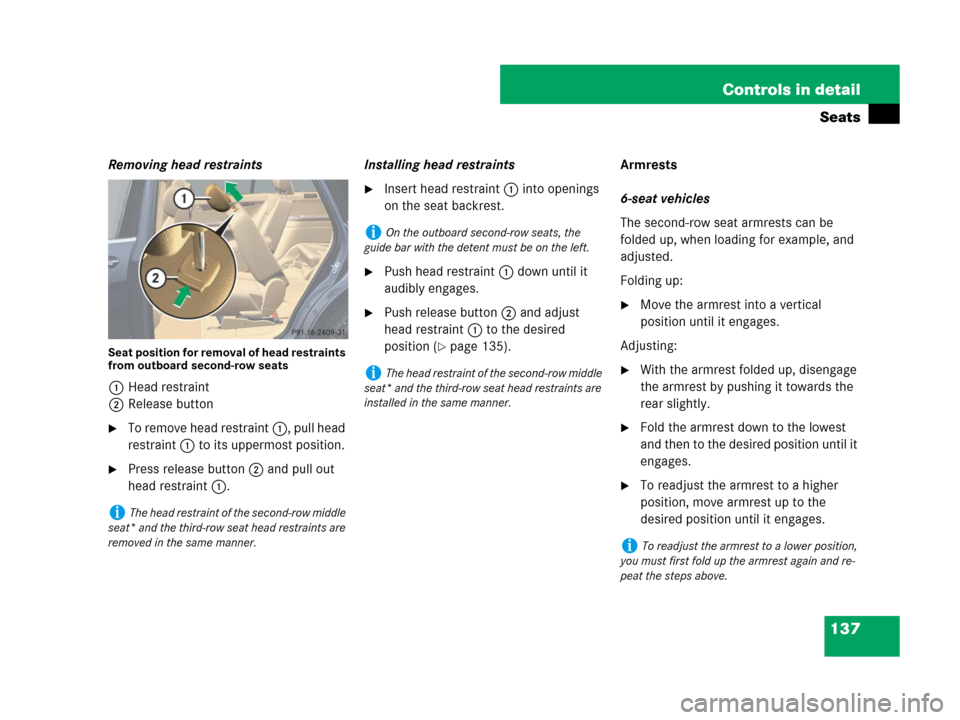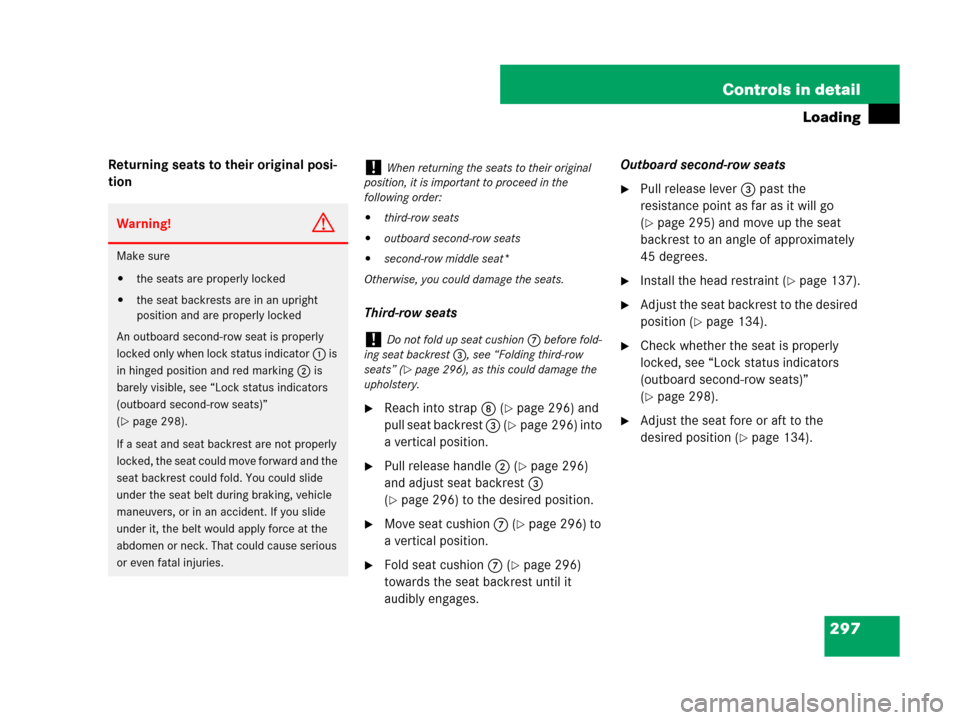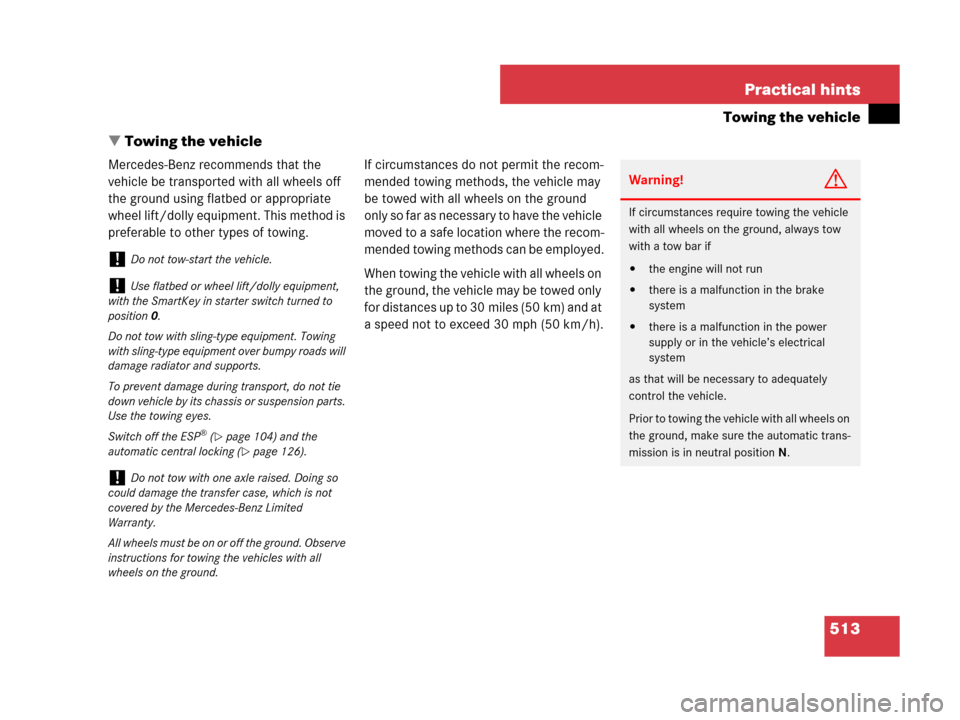Page 138 of 569

137 Controls in detail
Seats
Removing head restraints
Seat position for removal of head restraints
from outboard second-row seats
1Head restraint
2Release button
�To remove head restraint 1, pull head
restraint 1 to its uppermost position.
�Press release button2 and pull out
head restraint 1.Installing head restraints
�Insert head restraint 1 into openings
on the seat backrest.
�Push head restraint 1 down until it
audibly engages.
�Push release button2 and adjust
head restraint 1 to the desired
position (
�page 135).Armrests
6-seat vehicles
The second-row seat armrests can be
folded up, when loading for example, and
adjusted.
Folding up:
�Move the armrest into a vertical
position until it engages.
Adjusting:
�With the armrest folded up, disengage
the armrest by pushing it towards the
rear slightly.
�Fold the armrest down to the lowest
and then to the desired position until it
engages.
�To readjust the armrest to a higher
position, move armrest up to the
desired position until it engages.
iThe head restraint of the second-row middle
seat* and the third-row seat head restraints are
removed in the same manner.
iOn the outboard second-row seats, the
guide bar with the detent must be on the left.
iThe head restraint of the second-row middle
seat* and the third-row seat head restraints are
installed in the same manner.
iTo readjust the armrest to a lower position,
you must first fold up the armrest again and re-
peat the steps above.
Page 298 of 569

297 Controls in detail
Loading
Returning seats to their original posi-
tion
Third-row seats
�Reach into strap 8 (�page 296) and
pull seat backrest 3 (
�page 296) into
a vertical position.
�Pull release handle 2 (�page 296)
and adjust seat backrest 3
(
�page 296) to the desired position.
�Move seat cushion 7 (�page 296) to
a vertical position.
�Fold seat cushion 7 (�page 296)
towards the seat backrest until it
audibly engages.Outboard second-row seats
�Pull release lever 3 past the
resistance point as far as it will go
(
�page 295) and move up the seat
backrest to an angle of approximately
45 degrees.
�Install the head restraint (�page 137).
�Adjust the seat backrest to the desired
position (
�page 134).
�Check whether the seat is properly
locked, see “Lock status indicators
(outboard second-row seats)”
(
�page 298).
�Adjust the seat fore or aft to the
desired position (
�page 134).
Warning!G
Make sure
�the seats are properly locked
�the seat backrests are in an upright
position and are properly locked
An outboard second-row seat is properly
locked only when lock status indicator 1 is
in hinged position and red marking 2 is
barely visible, see “Lock status indicators
(outboard second-row seats)”
(
�page 298).
If a seat and seat backrest are not properly
locked, the seat could move forward and the
seat backrest could fold. You could slide
under the seat belt during braking, vehicle
maneuvers, or in an accident. If you slide
under it, the belt would apply force at the
abdomen or neck. That could cause serious
or even fatal injuries.
!When returning the seats to their original
position, it is important to proceed in the
following order:
�third-row seats
�outboard second-row seats
�second-row middle seat*
Otherwise, you could damage the seats.
!Do not fold up seat cushion 7 before fold-
ing seat backrest 3, see “Folding third-row
seats” (
�page 296), as this could damage the
upholstery.
Page 514 of 569

513 Practical hints
Towing the vehicle
�Towing the vehicle
Mercedes-Benz recommends that the
vehicle be transported with all wheels off
the ground using flatbed or appropriate
wheel lift/dolly equipment. This method is
preferable to other types of towing.If circumstances do not permit the recom-
mended towing methods, the vehicle may
be towed with all wheels on the ground
only so far as necessary to have the vehicle
moved to a safe location where the recom-
mended towing methods can be employed.
When towing the vehicle with all wheels on
the ground, the vehicle may be towed only
for distances up to 30 miles (50 km) and at
a speed not to exceed 30 mph (50 km/h).
!Do not tow-start the vehicle.
!Use flatbed or wheel lift/dolly equipment,
with the SmartKey in starter switch turned to
position0.
Do not tow with sling-type equipment. Towing
with sling-type equipment over bumpy roads will
damage radiator and supports.
To prevent damage during transport, do not tie
down vehicle by its chassis or suspension parts.
Use the towing eyes.
Switch off the ESP
® (�page 104) and the
automatic central locking (
�page 126).
!Do not tow with one axle raised. Doing so
could damage the transfer case, which is not
covered by the Mercedes-Benz Limited
Warranty.
All wheels must be on or off the ground. Observe
instructions for towing the vehicles with all
wheels on the ground.
Warning!G
If circumstances require towing the vehicle
with all wheels on the ground, always tow
with a tow bar if
�the engine will not run
�there is a malfunction in the brake
system
�there is a malfunction in the power
supply or in the vehicle’s electrical
system
as that will be necessary to adequately
control the vehicle.
Prior to towing the vehicle with all wheels on
the ground, make sure the automatic trans-
mission is in neutral positionN.